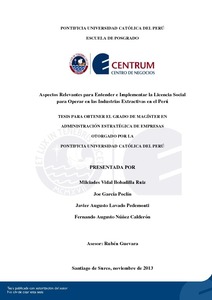| dc.contributor.advisor | Guevara Moncada, Rubén | |
| dc.contributor.author | Bobadilla Ruiz, Milciades Vidal | es_ES |
| dc.contributor.author | García Poclín, Joe | es_ES |
| dc.contributor.author | Lavado Pedemonti, Javier Augusto | es_ES |
| dc.contributor.author | Núñez Calderón, Fernando Augusto | es_ES |
| dc.date.accessioned | 2017-05-31T22:59:47Z | |
| dc.date.available | 2017-05-31T22:59:47Z | |
| dc.date.created | 2013 | |
| dc.date.issued | 2017-05-31 | |
| dc.identifier.uri | http://hdl.handle.net/20.500.12404/8718 | |
| dc.description.abstract | El propósito de esta investigación es entender e implementar la licencia social
para operar (LSO) en el contexto de las industrias extractivas en el Perú, a través de la
descripción de sus aspectos relevantes, los cuales son: (a) las empresas necesitan
internalizar la existencia de la LSO y desarrollar capacidades para gestionarla; (b)
tener una definición de LSO común entendida por todos; (c) identificar a los actores
involucrados en la negociación de la LSO y que sean aceptados por todos; (d) tener
claras las expectativas de las poblaciones de las comunidades donde operan los
proyectos para gestionarlas adecuadamente y evitar el surgimiento de conflictos
sociales; (e) los factores clave de éxito al momento de la negociación.
Para lograr comprender estos aspectos, se empleó el enfoque cualitativo de
tipo descriptivo. Se realizó el recojo de información mediante entrevistas en
profundidad a expertos. Como apoyo para el análisis, se utilizó la herramienta
informática Atlas ti. Asimismo, se emplearon fuentes secundarias para la obtención de
los aspectos relevantes de la LSO. Mediante el análisis de la información se
obtuvieron las siguientes conclusiones: (a) la LSO es un acuerdo informal que carece
de marco legal, (b) la identificación de quién otorga la LSO depende del área de
influencia y del interlocutor válido, (c) el conflicto social en el Perú es la expresión de
frustraciones debido a promesas incumplidas, (d) la gestión y el mantenimiento de la
LSO es un proceso paralelo y continuo a lo largo del ciclo de vida del proyecto, y (e)
los factores clave de éxito hallados en la investigación son similares a los señalados
por expertos internacionales.
Finalmente, los autores han propuesto un diagrama, basado en el análisis de las
entrevistas en profundidad y la revisión de literatura. En este diagrama, se
esquematiza la interrelación de los diferentes actores que participan y los factores
claves de éxito, relacionándolos a las diferentes etapas del ciclo de vida de la LSO | es_ES |
| dc.description.abstract | The purpose of this research is to understand and implement the social license
to operate (LSO) in the context of extractive industries in Peru, through the
description of its relevant aspects, which are: (a) companies need to internalize the
existence of the LSO and develop skills to manage it, (b) have a common definition of
LSO understood by all, (c) identify the actors involved in the negotiation of the LSO
and ensure they are accepted by everyone, (d) have clear the expectations of the
populations of the communities where the projects operate to properly manage them
and prevent the emergence of social conflict, (e) the key success factors at the time of
negotiation.
In order to understand these aspects, this research used a descriptive
qualitative approach. We performed the gathering of information through in-depth
interviews with experts. We performed the analysis with support of the Atlas.ti
computer tool. Also, secondary sources were used to obtain the relevant aspects of the
LSO. By analyzing the information obtained the following conclusions: (a) the LSO
is an informal agreement that lacks legal framework, (b) identification of who issues
the LSO depends on the area of influence and the right identification of the
interlocutor, (c) social conflict in Peru is the expression of frustration due to
unfulfilled promises, (d) the management and maintenance of the LSO is a parallel
and continuous process throughout the project life cycle, and (e) the key success
factors found in research are similar to those reported by international experts.
Finally, the authors have proposed a diagram, based on the analysis of the interviews
and the literature review, which outlines the interrelationship of the different actors
involved and key success factors, relating them to the different stages of the life cycle
of the social license to operate | es_ES |
| dc.language.iso | spa | es_ES |
| dc.publisher | Pontificia Universidad Católica del Perú | es_ES |
| dc.rights | Atribución-NoComercial-SinDerivadas 2.5 Perú | * |
| dc.rights | info:eu-repo/semantics/openAccess | es_ES |
| dc.rights.uri | http://creativecommons.org/licenses/by-nc-nd/2.5/pe/ | * |
| dc.subject | Industria minera -- Perú | es_ES |
| dc.subject | Industria minera -- Aspectos sociales -- Perú | es_ES |
| dc.subject | Investigación cualitativa | es_ES |
| dc.title | Aspectos relevantes para entender e implementar la licencia social para operar en las industrias extractivas en el Perú | es_ES |
| dc.type | info:eu-repo/semantics/masterThesis | es_ES |
| thesis.degree.name | Magíster en Administración Estratégica de Empresas | es_ES |
| thesis.degree.level | Maestría | es_ES |
| thesis.degree.grantor | Pontificia Universidad Católica del Perú. CENTRUM | es_ES |
| thesis.degree.discipline | Administración Estratégica de Empresas | es_ES |
| renati.advisor.orcid | https://orcid.org/0000-0002-4795-2557 | es_ES |
| renati.discipline | 413307 | es_ES |
| renati.level | https://purl.org/pe-repo/renati/level#maestro | es_ES |
| renati.type | https://purl.org/pe-repo/renati/type#tesis | es_ES |
| dc.publisher.country | PE | es_ES |
| dc.subject.ocde | https://purl.org/pe-repo/ocde/ford#5.02.04 | es_ES |






